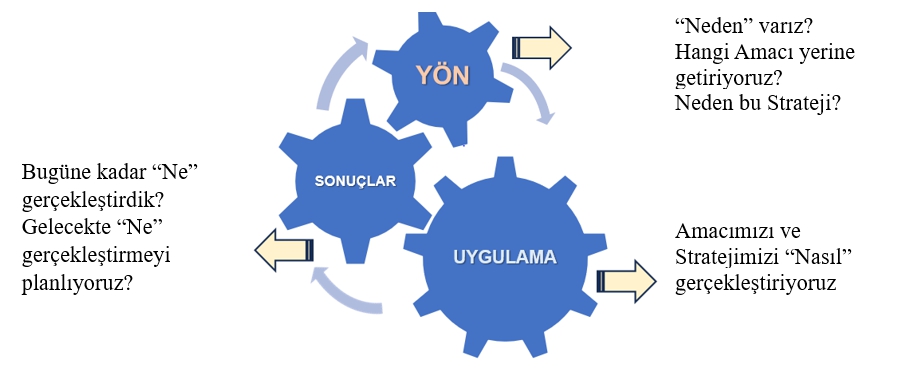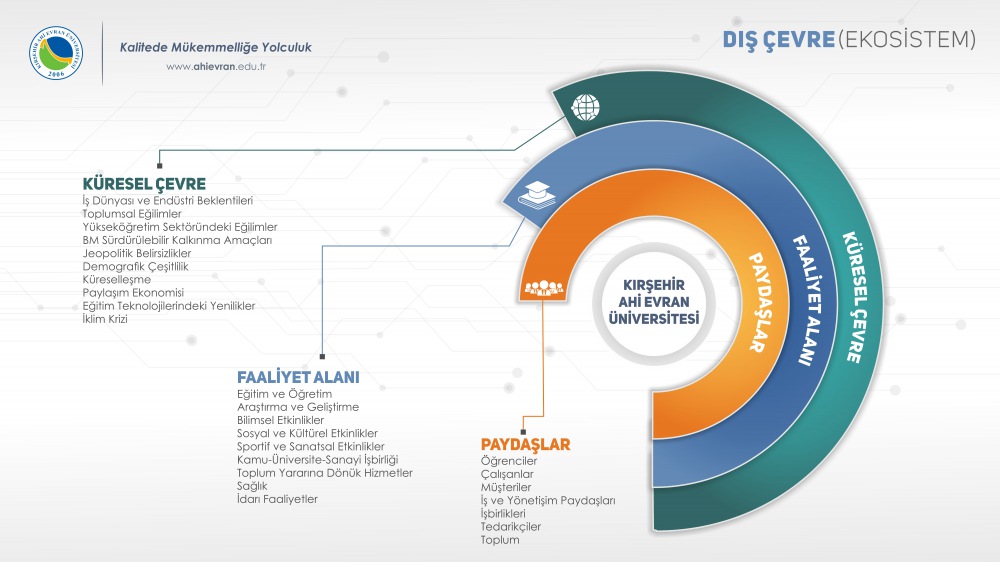Why do we apply the EFQM Model?
In addition to creating and delivering sustainable value propositions for its stakeholders, our faculty implements the EFQM Model as part of its obligation to care for the ecosystem in which it operates. The reasons for implementing the EFQM Model are as follows:
- Delivering value to the stakeholders of our faculty and improving its performance,
- To analyze the possible impacts of current and future market dynamics on the University's Purpose, Vision and Strategy,
- Analyzing the strategies of key stakeholders and determining their adequacy, shortcomings and suitability according to its own purpose, vision, strategy and business model,
- To determine our vision by taking into account the economic, environmental and social conditions in the higher education ecosystem in which we are located,
- To establish a culture of co-development instead of win-lose in our relations with other elements in our ecosystem,
- To identify opportunities and threats within the higher education ecosystem and respond to them in an agile, efficient and effective manner,
- To ensure that ethical values are reflected in all activities of the university and to make them a part of the corporate culture,
- To contribute to the transformation of the ecosystem with a strategic governance approach by creating goals that inspire stakeholders.
What is our EFQM Model Approach?
At the heart of our EFQM Model is the strong relationship between our University's Purpose and Strategy, and an understanding that this will help our Faculty create sustainable value for its key stakeholders and achieve superior performance results. Within the framework of this understanding, the EFQM Model approach of our University is as follows:

What do we expect from the EFQM Model?
In line with the principles stipulated by our Performance Based Process Management Model, the following are the issues we pay attention to when applying the EFQM Model:


What Does the EFQM Model Bring Us?
The EFQM Model that we are implementing offers us the opportunity to see the whole, to adopt a holistic perspective and to understand that our organization is a complex yet organized system. In addition, other benefits of the model are as follows:
- We see it as a fundamental requirement to strengthen the link between “Direction, Implementation and Results”, which are the basic elements of our systematic management approach, and to create a continuous and healthy life cycle.
- We adopt it as a necessity to evaluate the impact of our goals and vision on our stakeholders.
- In our management approach, we adopt a more collaborative leadership approach with less vertical/hierarchical structure, less use of power and less control.
- Recognizing the intrinsic values that come from working with a more diverse population, we care about creating strong bonds with our employees.
- In addition to daily routine activities, we care about being prepared for the future by successfully managing change.
- By adopting a way of thinking focused on creativity and innovation, we attach importance to increasing the value we offer and improving our performance.
- We consider our environmental policy, which aims to contribute to responsibility and sustainability, as part of our management approach.
- By adopting an approach of communication and cooperation with key stakeholders, we attach importance to stakeholder participation in decision-making processes and organizations in the management of change.
- We care about seeing the whole, adopting a holistic perspective and maintaining the existence of our Faculty as a complex yet organized system.
- We see bringing our employees to our Faculty as the basis of our human resources policy.
- We see benchmarking with our peers as part of our development process.
- We see our university as part of a complex and harmonious system of interdependent people in a dynamic and living world.

What do we expect from the EFQM Model?
- Ensuring unity of direction working on the basis of mission
- Guiding Corporate Culture for sustainable success
- Creating a stakeholder-oriented perspective and creating value for all stakeholders
- Ensuring a holistic system management perspective
In line with the principles stipulated by our Performance Based Process Management Model, the following are the issues we pay attention to when applying the EFQM Model:
- We identify our differentiation strategy and focus areas to meet stakeholder expectations in order to realize our purpose (mission) and vision and create benefits for the ecosystem.
- In line with the Strategic Plan Preparation Guide, we prioritize our stakeholders within our ecosystem and analyze stakeholder expectations. We categorize our stakeholders according to their importance and impact, and identify our key stakeholders according to the type of relationship we have established.
- We adopt stakeholder participation as a fundamental policy and take into account the opinions and suggestions of key stakeholders in the process of defining the purpose and vision.

- In our ecosystem, we recognize and appreciate exemplary models by adopting an approach based on the compliance of corporate decisions and policies with sustainability principles.
- We adopt an approach that focuses on learning and continuous improvement to realize our strategy and encourage our management and employees to contribute to change and development.
- We learn from our experiences and use the knowledge we gain to successfully manage change and transformation processes.
- We encourage innovative and creative thinking and enable stakeholders to share their original and creative ideas by creating “Innovative and Creative Thinking Platforms” at the unit level.
- We implement a “Performance-Based Process Management” business model, taking into account the public responsibility of our university and the competitive conditions in the ecosystem.

What Does the EFQM Model Bring Us?
The EFQM Model that we are implementing offers us the opportunity to see the whole, to adopt a holistic perspective and to understand that our organization is a complex yet organized system. In addition, other benefits of the model are as follows:
- It makes it easier to understand our stakeholders by looking at our faculty as a complex and harmonious system of interdependent people in a dynamic and living world.
- Knowing that we are part of a complex ecosystem enables us to interact more strongly and efficiently with other elements within our ecosystem.
- It teaches us to use the opportunities to learn and grow from all stakeholders in our ecosystem to our advantage.
- It teaches us how to be a leader in our own ecosystem by doing activities that inspire our stakeholders and evaluate what can be done for the benefit of us and the environment.
- By analyzing that we will face major changes in the future, it makes it easier to embrace the challenge of managing the present while anticipating the future and preparing to mitigate threats.
- Our supportive approach, which allows our stakeholders to communicate their innovative and creative ideas, enables us to establish sustainable relationships with our stakeholders and strengthen our existing relationships and collaborations.
- Our reward and appreciation practices encourage our employees to acquire behaviors in line with the core values of our university.
- Our management approach, which evaluates the negativities experienced in business processes as an opportunity for development and learning, provides employees and students with a supportive cultural environment that encourages learning and learning from mistakes.
- Our Experience Sharing policy strengthens our continuous improvement practice in the context of our corporate transformation goals.
- National and global environmental (ecosystem) analyses lead our Faculty to take action against the changes that have occurred/may occur in the ecosystem and to implement feasible transformation projects.
- Our human resources policy to improve the competencies of our employees contributes to transforming the existing facilities of our Faculty into ergonomic working environments within the legal framework.
